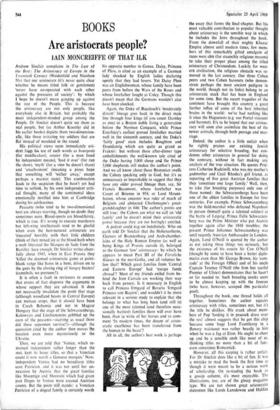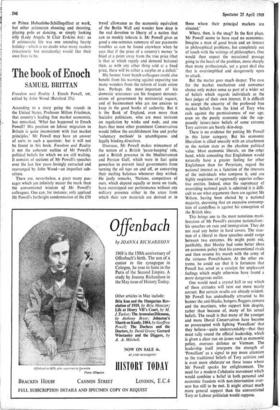Are aristocrats people? BOOKS
LAIN MONCREIFFE OF THAT ILK
Andrew Sinclair complains in The Last of the Best : The Aristocracy of Europe in the Twentieth Century (Weidenfeld and Nicolson 50s) that our aristocrats (it's never quite clear whether he means titled folk or gentlemen) 'never have co-operated with each other against the pressures of society': by which I hope he doesn't mean ganging up against the rest of the People. This is because the aristocracy are not only people, like everybody else in Britain, but probably the most independent-minded group among the People. Dr Sinclair doesn't quite see them as real people, but (as Arthur Koestler did in his earlier books) depicts them two-dimension- ally, like those irritating toy soldiers that are flat instead of moulded in the round.
His political views seem immediately evi- dent from his use of such words as bourgeois (for middle-class), rentier (for a man freed by independent means), 'lord it over' (for run the show), 'myth' (for a view he doesn't share) and 'anachronism' (meaning a pious hope that something will 'wither away,' except perhaps a marxist state). This combination leads to the suspicion that he hasn't yet had time to rethink, by his own independent criti- cal thought, many of -the continental ideas emotionally instilled into him at Cambridge during his adolescence.
Peasants (who tend to be two-dimensional too) are always starving, though no doubt they sometimes were. Blood-sports are bloodthirsty, which is true. It's wrong to execute murderers but left-wing intellectuals tend to be gleeful when even the best-natured aristocrats are 'executed' horribly with their little children (think of their mixed joy at the blood-bath when a mob liberated the Marquis de Sade from the Bastille). Sure enough, Dr Sinclair writes cheer- fully about 1945, when in East Prussia they 'killed the doomed aristocratic game at point-. blank range like hares in a hunt, driven on to the guns by the closing ring of hungry beaters' (cannibals, we presume?).
It is often a fault in reviewers to assume that errors of fact disprove the arguments in whose support they are advanced. It does not necessarily invalidate the point that stags (although woodland beasts in Central Europe) can menace crops, that it should have been in Czech Bohemia and not in Magyar Hungary that the stags of the Schwarzenbergs, Kolowrats and Liechtensteins gobbled up the corn of the peasants—starving as usual (how did these supermen survive?)—although the quotation cited by the author then moves 'the location even more mysteriously to the Ukraine.
Then, we are told that 'Venice, which re- mained independent rather longer than the rest, kept its lesser titles, so that a Venetian count is now worth a Genoese marquis.' Now, independent Venice had no hereditary titles save Patrician, and it was not until her an- nexation by Austria that the great► families like Mocenigo and Morosini which had given past Doges to Venice were created Austrian counts. But the point still stands: a Venetian Patrician of a dogeal family is certainly worth his opposite number in Genoa. Daisy, Princess of Pless, is cited as an example of a German lady shocked by English ladies declaring openly that they had lovers. Yet Daisy Pless was an Englishwoman, whose family have been peers from before the Wars of the Roses and whose forefather fought at Crecy. Though this doesn't mean that the Germans wouldn't also have been shocked.
Again, the Duke of. Buccleuch's 'moderately distant' lineage goes back in the direct male line through four kings (if you count Darnley as one) to a Breton noble living a generation before the Norman Conquest, while Prince Esterhazy's earliest proved forefather married well in the sixteenth century, and the Duke's 'fairly good' state includes Boughton and Drumlanrig which are quite as grand as Frakn6 : but without these after-dinner -type embellishments the well-known tale cited of the Duke having 5,000 sheep and The Prince 5,000 shepherds still makes the author's point. And we all know about those Bostonian swells the Cabots speaking only to God, but it's as unnecessary as improbable to suggest that they have any older proved lineage than, say, Sir Francis Beaumont, whose forefather was Count of Brienne in 954, or Lord Mount- batten, whose ancestor was ruler of much of Belgium and abducted Charlemagne's great- granddaughter in 84E4 The author's points are still true: the Cabots are what we call an 'old family' and he doesn't mind their aristocratic power because they are (so boringly) untitled.
A pedant could nag on indefinitely. Who on earth told Dr Sinclair that the Hohenzollerns, Electors of Brandenburg and Arch-chamber- lains of the Holy Roman Empire (as well as being Kings of Prussia outside it), belonged to the German 'low' aristocracy: by which he appears to mean Part III of the Fiirstliche Hauser in the neo-Gotha, and all volumes be- low that? Which great families from 'Central and Eastern Europe' had 'escape funds abroad'? Most of my friends exiled from be- hind the Iron Curtain are working their way back from penury. Is it necessary in English to call Princess Irmgard of Bavaria 'Irmgard Princess von Bayern'; and wouldn't it be more relevant in a serious study to explain that she belongs to what has long been (and still is) one of the most talented (and therefore occa- sionally battiest) families there will ever have been, than to write of her horses and to com- ment 'In modern times, the dream of aristo- cratic excellence has been transferred from the human to the beast'?
All in all, the author's best work is perhaps
the essay that forms tie final -chapter. But his most valuable contribution to popular thought about aristocracy is the sensible way in which he includes the Jews throughout the ,book. From the downfall of their mighty Khazar Empire almost until modern times, few mem- bers of this remarkably gifted amalgam of races were able (for staunchly religious reasons) to take their proper place among the titled aristocracy of Christendom. Luckily for west- ern civilisation, the religious obstacle was re- moved in the last century. Our three Cohen peers and two Cohen baronets (who demon- strate perhaps the most ancient pedigree in the world, though not its links) belong to an aristocratic stock that has been in England for some time. But the recent tragedies of the continent have brought this country a great further influx of some of the best inherited brains in the world: we've had nothing like it since the Huguenots (e.g. our Portal viscount and baronet). It's to be hoped that our aristoc- racy will soon also assimilate the best of the newer arrivals, through both peerage and mar- riage.
Indeed, the author is a little unfair when he rightly praises our existing Jewish aristocracy for selective breeding, but con- demns other aristocrats in general for doing the contrary, without in fact making any analysis of the true situation. He quotes Prin- cess Catherine Radziwill, who was my mother's godmother and Cecil Rhodes's girl friend, as reporting of five great Austrian families that they 'constitute one large family.' Well, then, to take (for breeding purposes) only one of those named : the Schwarzenbergs have been one of the ablest families in Europe for four centuries. For example, Prince Schwarzenberg was the field-marshal who defeated Napoleon in person (himself quite a talented soldier) at the battle of Leipzig; Prince Felix Schwarzen- berg was the Prime Minister who put Austria together again after the 1848 troubles; the present, Prince Johannes Schwarzenberg was until'recently Austrian Ambassador in London. Again, Lord O'Neill is quoted by the author as not taking these things too seriously, but the existence of his cousin Sir Con O'Neill (thought by some to have been a better diplo- matist even than Mr George Brown, his 'com- rade' at the Foreign Office) and of his uncle Captain Terence O'Neill (the firm but tactful Premier of Ulster) demonstrates that he hasn't so far needed to. Such breeding stocks seem to be almost keeping up with the Joneses (who have, however, scooped this particular pool).
Throughout the book, one thread bolds all together. Sometimes the author equates aristocracy with titles, sometimes not, but it's the title he dislikes. His crack about mem- bers of Pop 'lording it in peacock dress over the rest' almost suggests that he got this chip because some huge Lord Fauntleroy in a flowery waistcoat was rather beastly to him when he was a fag at Eton. He ought to cheer up and be a sensible snob like most of us, thinking titles no more than a bit of fun: even sometimes Romantick.
However, all this carping is rather unfair. For Dr Sinclair does like a bit of fun. It was a mistake to read the book the first time as though it were meant to be a serious work of scholarship. On re-reading the book as a gossip column, it's most enjoyable. The illustrations, too, are of the glossy magazine type. We are not shown great aristocratic statesmen like Lords Lansdowne and Halifax or Prince Hohenlohe-Schillingsflirst at work, but other aristocrats shooting and shooting, playing polo or dancing, or simply looking silly (Lady Angela St Clair Erskine bis): as if aristocratic life was one unending hearty holiday—which is no doubt what many readers (vicariously but mistakenly) would like their own lives to be.











































 Previous page
Previous page